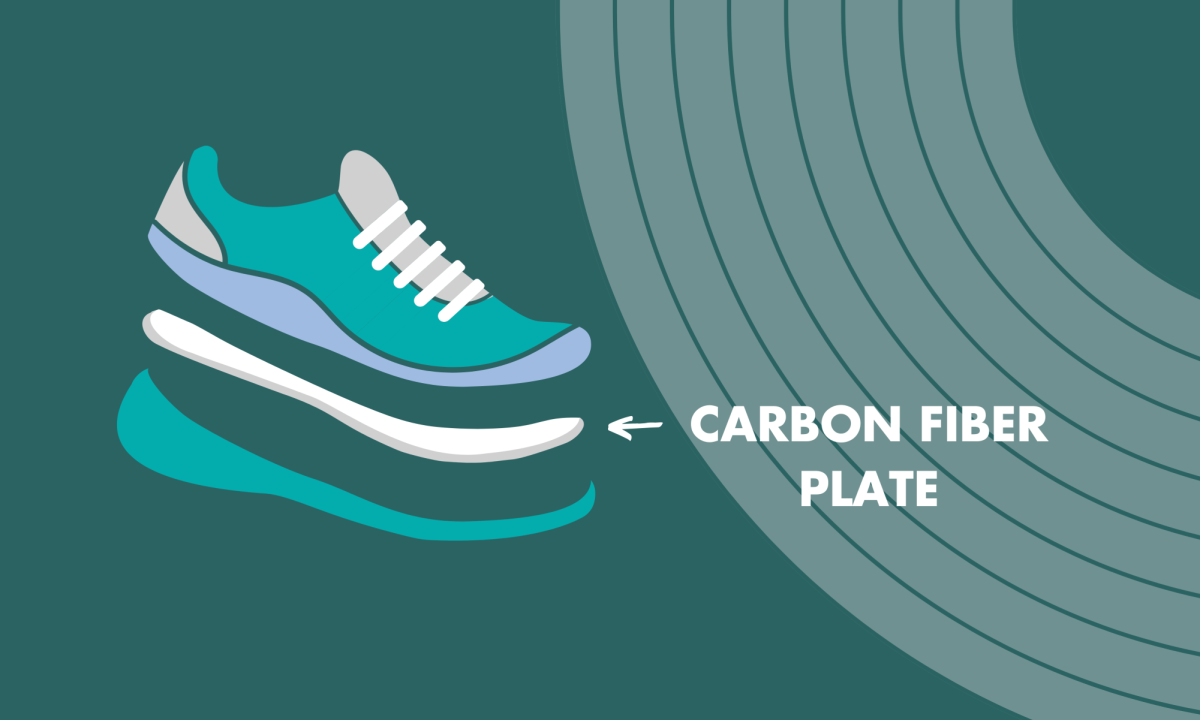
GRAPHIC: CARA HALLIGAN ’25/THE HAWK
At first glance, carbon-plated running shoes may seem like the average running shoe, but when you try them out, you might feel like you’re running on trampolines.
Carbon-plated running shoes are the new it-shoes in the running community. These new sneakers are foam shoes with a thin sheet of carbon fiber that is incredibly strong and stiff. This material adds durability, stability and even propulsion.
Since the market release of the first carbon-plated shoe in 2017, most elite runners have never looked back on regular running shoes. Dylan Zuch ’22, PharmD ’24, a runner for the Philadelphia Runner Track Club, is a fan, and prefers them over his running spikes.
“Since I have been introduced to them, even if you’re doing 200s on the track, I still would wear them over putting on spikes because it is slightly less aggressive,” Zuch said.
By wearing carbon-plated running shoes during a workout or race, you are increasing your speed and efficiency. The science behind the shoes is that when your foot strikes the ground, the carbon fiber plate bends slightly before snapping back into place, which helps push the foot forward. When you run, you lose energy every time you hit the ground. The combination of the foam in the shoes and the carbon causes the shoes to feel like springs, helps you store energy and almost literally pushes you back into the air.
Carbon-plated shoes are scientifically proven to shave seconds and even minutes off your running times. As the shoes develop, running companies are looking for more ways to include carbon fiber into their products.
“They have a carbon fiber plate embedded in the sole, and that keeps the shoe rigid,” explained Justin Bennett, who works as a keyholder at Philadelphia Runner at the Manayunk location. “As you run, it propels you forward and gives you a competitive advantage.”
But the shoes are not without controversy. In the 2020 Tokyo Olympics, Nike’s first carbon-plate shoe, the Vaporfly 4%, just barely avoided a ban due to the advantageous 4% performance increase over regular running shoes. Since Nike was the first to create the shoe and released it shortly before the Olympics, other shoe companies didn’t have the chance to keep up with the new technology.
While he doesn’t own a pair of carbon-plated shoes, runner Eddie Dolan ’25 said he understands the appeal.
“For a runner, your shoes are your equipment,” Dolan said. “So, if you have good shoes, then that’s good for you. Obviously, there’s a disparity between who can afford nice shoes but … if you have good shoes, then that helps you out.”
Cost is definitely a factor with carbon-plated shoes. A pair of Nike Vaporflys are on the market for about $260. Now that other companies have their own versions of carbon-plated shoes, they can ultimately be found at any running shoe company or available online for purchase, and often fall in the $100-200 range.
“Not everyone can afford them, which is tough,” Zuch said. “But I think they’re fair game.”